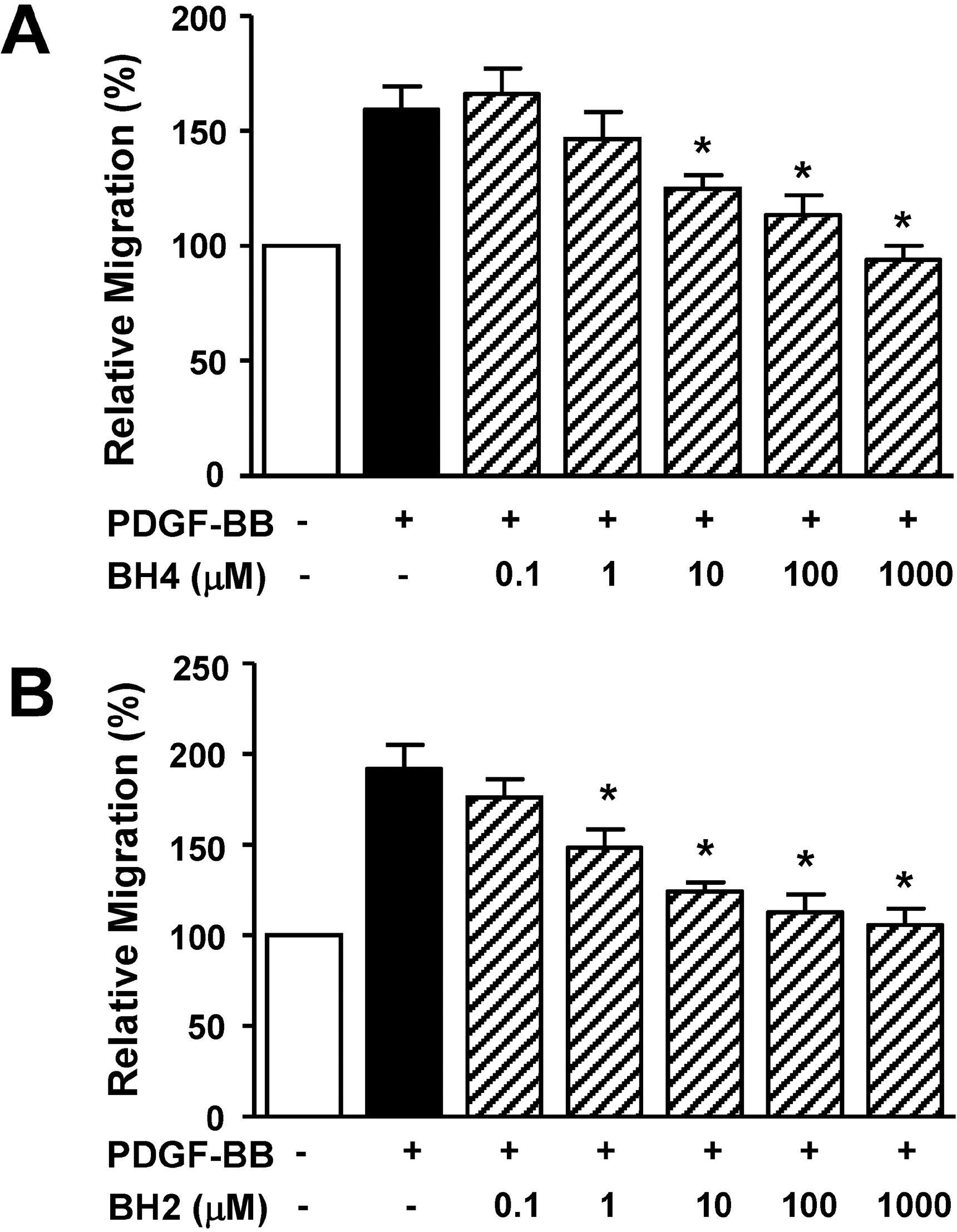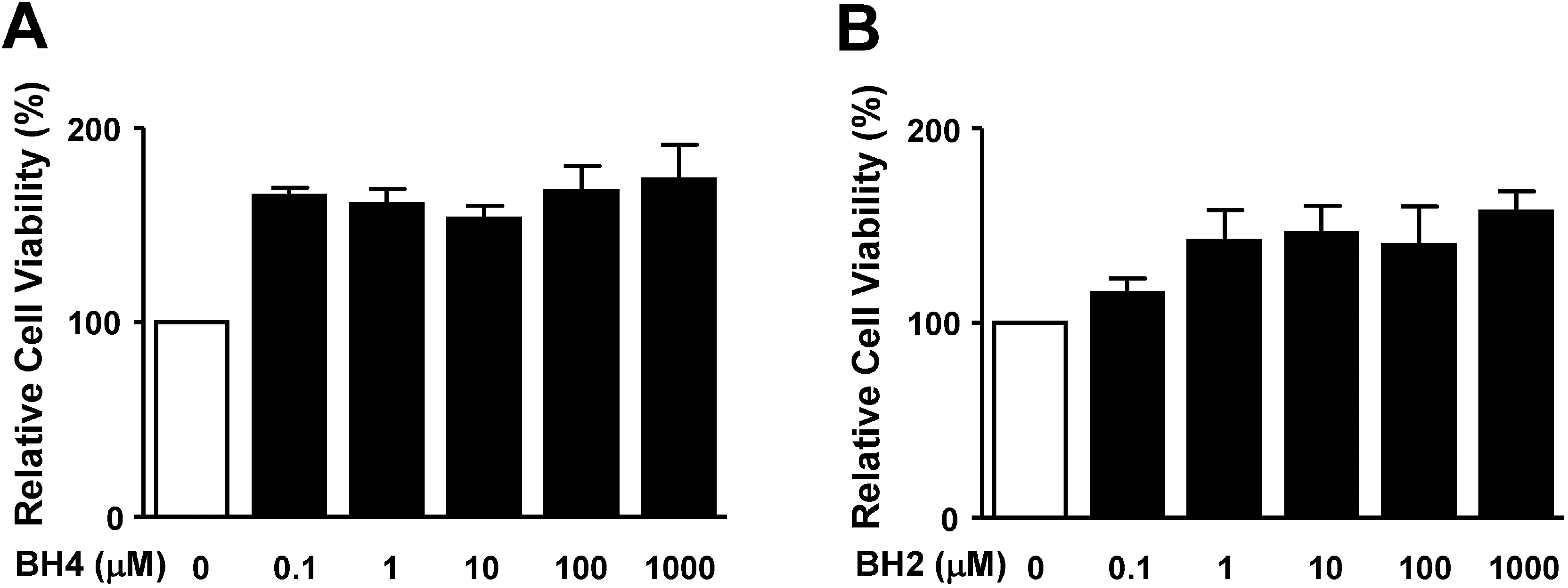Abstract
Tetrahydrobiopterin (BH4), an essential cofactor for nitric oxide synthase (NOS) activity, is known to play important roles in modulating both NO and superoxide production during vascular diseases such as atherosclerosis. However, the role of BH4 in functions of vascular smooth muscle cells is not fully known. In this study, we tested the effects of BH4 and dihydrobiopterin (BH2), a BH4 precursor, on migration and proliferation in response to platelet-derived growth factor-BB (PDGF-BB) in rat aortic smooth muscle cells (RASMCs). Cell migration and proliferation were measured using a Boyden chamber and a 5-bromo-2′-deoxyuridine incorporation assay, respectively, and these results were confirmed with an ex vivo aortic sprout assay. Cell viability was examined by 2,3-bis [2-methoxy-4-nitro-5-sulfophenyl]-2H-tetrazolium-5-carboxanilide assays. BH4 and BH2 decreased PDGF-BB-induced cell migration and proliferation in a dose-dependent manner. The inhibition of cell migration and proliferation by BH4 and BH2 was not affected by pretreatment with NG-nitro-L-arginine methyl ester, a NOS inhibitor. Moreover, the sprout outgrowth formation of aortic rings induced by PDGF-BB was inhibited by BH4 and BH2. Cell viability was not inhibited by BH4 and BH2 treatment. The present results suggest that BH4 and BH2 may inhibit PDGF-stimulated RASMC migration and proliferation via the NOS-independent pathway. Therefore, BH4 and its derivative could be useful for the development of a candidate molecule with an NO-independent anti-atherosclerotic function.
References
1. Nichol CA, Lee CL, Edelstein MP, Chao JY, Duch DS. Biosynthesis of tetrahydropterin by de novo and savage pathways in adrenal medulla extracts, mammalian cell cultures, and rat brain in vitro. Proc Natl Acad Sci USA. 1983; 80:1546–1550.
2. Kwon NS, Nathan CF, Stuehr DJ. Reduced biopterin as a cofactor in the generation of nitrogen oxides by murine macrophages. J Biol Chem. 1989; 264:20496–20501.

3. Mayer B, Werner ER. In search of function for tetrahy-drobipterin in the biosynthesis of nitric oxide. Arch Pharmacol. 1995; 351:453–463.

4. Moens AL, Kass DA. Tetrahydrodiopterin and cardiovascular disease. Aterioscler Thromb Vasc Biol. 2006; 26:2439–2444.
5. Zheng J, Yang X, Keith J, Christian H, Fing GD, Gerogory K, Imre K, Chen AF. Gene transfer of human guanosine 5′-triphosphate cyclohydrolase I restores vascular tetrahydrobiopterin level and endothelial function in low rennin hypertension. Circulation. 2003; 108:1238–1245.
6. Yang S, Lee YJ, Kim J, Park S, Peris J, Laipis P, Park YS, Chung JHC, Oh SP. A murine model for human sepiapterin reductase deficiency. Am J Hum Genet. 2006; 78:575–587.
7. Nicholas JA, Keith M. Regulation of endothelial nitric oxide synthase by tetrahydrobiopterin in vascular disease. Aterioscler Thromb Vas Biol. 2004; 24:413–420.
8. Wang CH, Li SH, Weisel RD, Fedak PW, Hung A, Li RK, Rao V, Hyland K, Cherng WJ, Errett L, Leclerc Y, Bonneau D, Latter DA, Verma S. Tetrahydrobiopterin deficiency exaggerates intimal hyperplasia after vascular injury. Am J Physiol Regul Integr Comp Physiol. 2005; 289:R299–R304.

9. Ali ZA, Bursill CA, Douglas G, McNeill E, Papaspyridonos M, Tatham AL, Bendall JK, Akhtar AM, Alp NJ, Greaves DR, Channon KM. CCR2-mediated anti-inflammatory effects of endothelial tetrahydrobiopterin inhibit vascular injury-induced accelerated atherosclerosis. Circulation. 2008; 118:S71–S77.

10. Lee CK, Han JS, Won KJ, Jung SH, Park HJ, Lee HM, Kim J, Park YS, Kim HJ, Park PJ, Park TK, Kim B. Diminished expression of dihydropteridine reductase is a potent biomarker for hypertensive vessels. Proteomics. 2009; 9:4851–4858.

11. Lee HM, Jeon BH, Won KJ, Lee CK, Park TK, Choi WS, Bae YM, Kim HS, Lee SK, Park SH, Irani K, Kim B. Gene transfer of redox factor-1 inhibits neointimal formation: involvement of platelet-derived growth factor-beta receptor signaling via the inhibition of the reactive oxygen species-mediated Syk pathway. Circ Res. 2009; 104:219–227.
13. Lee CK, Lee HM, Kim HJ, Park HJ, Won KJ, Roh HY, Choi WS, Jeon BH, Park TK, Kim B. Syk contributes to PDGF-BB-mediated migration of rat aortic smooth muscle cells via MAPK pathways. Cardiovasc Res. 2007; 74:159–168.

14. Heldin CH, Westermark B. Mechanism of action and in vivo role of platelet-derived growth factor. Physiol Rev. 1999; 79:1283–1316.

15. Won KJ, Lee SC, Lee CK, Lee HM, Lee SH, Fang Z, Choi OB, Jin M, Kim J, Park T, Choi WS, Kim SK, Kim B. Cordycepin attenuates neointimal formation by inhibiting reactive oxygen species-mediated responses in vascular smooth muscle cells in rats. J Pharmacol Sci. 2009; 109:403–412.

16. Sachinidis A, Locher R, Vetter W, Tatje D, Hoppe J. Different effects of platelet-derived growth factor isoforms on rat vascular smooth muscle cells. J Biol Chem. 1990; 265:10238–10243.

17. Moens AL, Kass DA. Therapeutic potential of tetrahydrobiopterin for treating vascular and cardiac disease. J Cardiovasc Pharmacol. 2007; 50:238–246.

18. Anastasiadis PZ, Bezin L, Imerman BA, Kuhn DM, Louie MC, Levine RA. Tetrahydrobiopterin as a mediator of PC12 cell proliferation induced by EGF and NGF. Eur J Neurosci. 1997; 9:1831–1837.
19. Shimizu S, Yasuda M, Ishii M, Nagai T, Kiuchi Y, Yamamoto T. Stimulation of in vitro angiogenesis by tetrahydrobiopterin in bovine aortic endothelial cells. Jpn J Pharmacol. 1999; 80:177–180.

20. Stein CS, Fabry Z, Murphy S, Hart MN, Stein CS, Fabry Z, Murphy S, Hart MN. Involvement of nitric oxide in IFN-γ-mediated reduction of microvessel smooth muscle cell proliferation. Mol Immunol. 1995; 32:965–973.

21. Sarkar R, Meinberg EG, Stanley JC, Gordon D, Webb RC. Nitric oxide reversibly inhibits the migration of cultured vascular smooth muscle cells. Circ Res. 1996; 78:225–230.

22. Lee HM, Lee CK, Lee SH, Roh HY, Bae YM, Lee KY, Lim J, Park PJ, Park TK, Lee YL, Won KJ, Kim B. p38 mitogen-activated protein kinase contributes to angiotensin II-stimulated migration of rat aortic smooth muscle cells. J Pharmacol Sci. 2007; 105:74–81.

23. Hasegawa H, Sawabe K, Nakanishi N, Wakasugi OK. Delivery of exogenous tetrahydrobiopterin (BH4) to cells of target organs: role of salvage pathway and uptake of its precursor in effective elevation of tissue BH4. Mol Genet Metab. 2005; 86:S2–S10.

24. Anastasiadis PZ, Jiang H, Bezin L, Kuhn DM, Levine RA. Tetrahydrobiopterin enhances apoptotic PC12 cell death following withdrawal of trophic support. J Biol Chem. 2001; 276:9050–9058.

25. Dawson TM, Snyder SH. Gases as biological messengers: nitric oxide and carbon monoxide in the brain. J Neurosci. 1994; 14:5147–5159.

26. Yetik-Anacak G, Catravas JD. Nitric oxide and the endothelium: history and impact on cardiovascular disease. Vascul Pharmacol. 2006; 45:268–276.

27. Puddu GM, Cravero E, Arnone G, Muscari A, Puddu P. Molecular aspects of atherogenesis: new insights and unsolved questions. J Biomed Sci. 2005; 12:839–853.

28. Katusic ZS. Vascular endothelial dysfunction: does tetrahydrobiopterin play a role? Am J Physiol Heart Circ Physiol. 2001; 281:H981–H986.

29. Alp NJ, Channon KM. Regulation of endothelial nitric oxide synthase by tetrahydrobiopterin in vascular disease. Arterioscler Thromb Vasc Biol. 2004; 24:413–420.

30. Nakaki T, Nakayama M, Kato R. Nakaki T, Nakayama M, Kato R. Inhibition by nitric oxide and nitric oxide-producing vasodilators of DNA synthesis in vascular smooth muscle cells. Eur J Pharmacol. 1990; 189:347–353.
Fig. 1.
Effects of BH4 and BH2 on PDGF-BB-induced migration of RASMCs. PDGF (10 ng/ml) and BH4 (0.1∼1,000 μM; A) or BH2 (0.1∼1,000 μM; B) were loaded in the upper chamber and incubated for 90 min (n=9). Migration was examined using a Boyden chamber assay. The migration of RASMCs in the quiescent state was expressed as 100% (n=9). ∗p<0.05 vs. the PDGF-BB-stimulated response in the absence of BH2 or BH4.

Fig. 2.
Effects of BH4 and BH2 on PDGF-BB-induced proliferation of RASMCs. RASMCs were treated with BH4 (0.1∼1,000 μM; A) or BH2 (0.1∼1,000 μM; B) and then stimulated with PDGF-BB (10 ng/ml) for 36 h. Cell proliferation was quantified using a BrdU incorporation assay. Proliferation in the quiescent state was expressed as 100% (n=8). ∗p<0.05 vs. the PDGF-BB-induced response in the absence of BH2 or BH4.

Fig. 3.
Effects of NOS inhibition on BH4- and BH2-induced inhibition of migration of RASMCs. After treatment with L-NAME (1 and 3 mM) and/or BH4 (100 μM; A) or BH2 (100 μM; B), the cells were loaded into the upper chamber containing PDGF-BB (10 ng/ml) and incubated for 90 min (n=8), as described in the Methods section. Cell migration in the quiescent state was expressed as 100% (n=8). ∗p<0.05 vs. the PDGF-BB-stimulated response in the absence of BH2 and BH4.

Fig. 4.
Effects of BH4 and BH2 on PDGF-BB-induced sprout formation of aortic rings. (A) Aortic rings (1-mm) embedded and cultured in Matrigel were treated with PDGF-BB, vehicle (0.1% DMSO), and BH4 or BH2. The effects were observed on day 5 of the stimulation. Upper panels: effects of vehicle and PDGF-BB (10 ng/ml) on the outgrowth of aortic-ring sprouts. Middle and lower panels: representative photographs showing the effects of BH4 (0.1∼1,000 μM) and BH2 (0.1∼1,000 μM), respectively. (B, C) The statistical data obtained from panel A. The sprout length level in vehicle-treated rings was expressed as 100% (n=4). ∗p<0.05 vs. the PDGF-BB-induced responses in the absence of BH2 and BH4.

Fig. 5.
Effects of BH4 and BH2 on RASMC viability. Cell viability was evaluated by the XTT assay as described in the Methods section. RASMCs were treated with BH4 (0.1∼1,000 μM; A) or BH2 (0.1∼1,000 μM; B) for 24 h. After addition of the XTT dye, cells were incubated for 4 h. Cell viability was quantified by measuring optical density values with an enzyme-linked immunosorbent assay reader at 450 nm. Cell viability in the quiescent state was considered 100% (n=4).





 PDF
PDF ePub
ePub Citation
Citation Print
Print


 XML Download
XML Download